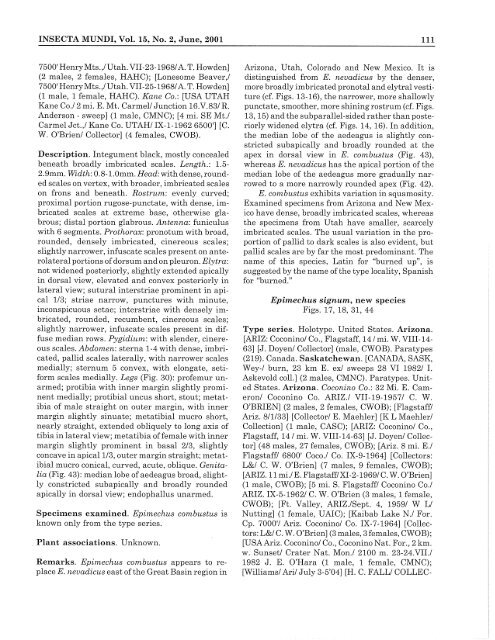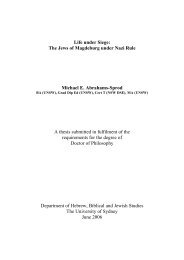Epimechus Dietz (Coleoptera: Curculionidae: Anthonomini)
Epimechus Dietz (Coleoptera: Curculionidae: Anthonomini)
Epimechus Dietz (Coleoptera: Curculionidae: Anthonomini)
Create successful ePaper yourself
Turn your PDF publications into a flip-book with our unique Google optimized e-Paper software.
INSECTA MUNDI, Vol. 15, No.2, June, 2001<br />
7500' Henry Mts.,!Utah. VII-23-1968/ A. T. Howden]<br />
(2 males, 2 females, HAHC); [Lonesome Beaver,!<br />
7500'Henry Mts.,!Utah. VII-25-1968/ A. T. Howden]<br />
(1 male, 1 female, HAHC). Kane Co.: [USA UTAH<br />
Kane Co.! 2 mi. E. Mt. Carmel/ Junction 16.V.83/ R.<br />
Anderson - sweep] (1 male, CMNC); [4 mi. SE Mt.!<br />
Carmel Jct.,! Kane Co. UTAH/ IX-1-1962 6500'] [C.<br />
W. O'Brien/ Collector] (4 females, CWOB).<br />
Description. Integument black, mostly concealed<br />
beneath broadly imbricated scales. Length.: 1.5-<br />
2.9mm. Width: 0.8-1.0mm. Head: with dense, rounded<br />
scales on vertex, with broader, imbricated scales<br />
on frons and beneath. Rostrum: evenly curved;<br />
proximal portion rugose-punctate, with dense, imbricated<br />
scales at extreme base, otherwise glabrous;<br />
distal portion glabrous. Antenna: funiculus<br />
with 6 segments. Pro thorax: pronotum with broad,<br />
rounded, densely imbricated, cinereous scales;<br />
slightly narrower, infuscate scales present on anterolateral<br />
portions of dorsum and on pleuron. Elytra:<br />
not widened posteriorly, slightly extended apically<br />
in dorsal view, elevated and convex posteriorly in<br />
lateral view; sutural interstriae prominent in apical<br />
1/3; striae narrow, punctures with minute,<br />
inconspicuous setae; interstriae with densely imbricated,<br />
rounded, recumbent, cinereous scales;<br />
slightly narrower, infuscate scales present in diffuse<br />
median rows. Pygidium: with slender, cinereous<br />
scales. Abdomen: sterna 1-4 with dense, imbricated,<br />
pallid scales laterally, with narrower scales<br />
medially; sternum 5 convex, with elongate, setiform<br />
scales medially. Legs (Fig. 30): profemur unarmed;<br />
protibia with inner margin slightly prominent<br />
medially; protibial uncus short, stout; metatibia<br />
of male straight on outer margin, with inner<br />
margin slightly sinuate; metatibial mucro short,<br />
nearly straight, extended obliquely to long axis of<br />
tibia in lateral view; metatibia offemale with inner<br />
margin slightly prominent in basal 2/3, slightly<br />
concave in apical 1/3, outer margin straight; metatibial<br />
mucro conical, curved, acute, oblique. Genitalia<br />
(Fig. 43): median lobe of aedeagus broad, slightly<br />
constricted subapically and broadly rounded<br />
apically in dorsal view; endophallus unarmed.<br />
Specimens examined. <strong>Epimechus</strong> combustus is<br />
known only from the type series.<br />
Plant associations. Unknown.<br />
Remarks. <strong>Epimechus</strong> combustus appears to replace<br />
E. nevadicus east ofthe Great Basin region in<br />
111<br />
Arizona, Utah, Colorado and New Mexico. It is<br />
distinguished from E. nevadicus by the denser,<br />
more broadly imbricated pronotal and elytral vestiture<br />
(cf. Figs. 13-16), the narrower, more shallowly<br />
punctate, smoother, more shining rostrum (cf. Figs.<br />
13, 15) and the subparallel-sided rather than posteriorly<br />
widened elytra (cf. Figs. 14, 16). In addition,<br />
the median lobe of the aedeagus is slightly constricted<br />
subapically and broadly rounded at the<br />
apex in dorsal view in E. combustus (Fig. 43),<br />
whereas E. nevadicus has the apical portion of the<br />
median lobe of the aedeagus more gradually narrowed<br />
to a more narrowly rounded apex (Fig. 42).<br />
E. combustus exhibits variation in squamosity.<br />
Examined specimens from Arizona and New Mexico<br />
have dense, broadly imbricated scales, whereas<br />
the specimens from Utah have smaller, scarcely<br />
imbricated scales. The usual variation in the proportion<br />
of pallid to dark scales is also evident, but<br />
pallid scales are by far the most predominant. The<br />
name of this species, Latin for "burned up", is<br />
suggested by the name of the type locality, Spanish<br />
for "burned."<br />
<strong>Epimechus</strong> signum, new species<br />
Figs. 17, 18,31,44<br />
Type series. Holotype. United States. Arizona.<br />
[ARIZ: Coconino/ Co., Flagstaff, 14/ mi. W. VIII-14-<br />
63] [J. Doyen/ Collector] (male, CWOB). Paratypes<br />
(219). Canada. Saskatchewan. [CANADA, SASK,<br />
Wey-/ burn, 23 km E. ex/ sweeps 28 VI 1982/ 1.<br />
Askevold coIl.] (2 males, CMNC). Paratypes. United<br />
States. Arizona. Coconino Co.: 32 Mi. E. Cameron!<br />
Coconino Co. ARIZ.! VII-19-1957/ C. W.<br />
O'BRIEN] (2 males, 2 females, CWOB); [Flagstaff/<br />
Ariz. 8/1/33] [Collector/ E. Maehler] [K L Maehler/<br />
Collection] (1 male, CASC); [ARIZ: Coconino/ Co.,<br />
Flagstaff, 14/ mi. W. VIII-14-63] [J. Doyen/ Collector]<br />
(48 males, 27 females, CWOB); [Ariz. 8 mi. E.!<br />
Flagstaff/ 6800' Coco.! Co. IX-9-1964] [Collectors:<br />
L&/ C. W. O'Brien] (7 males, 9 females, CWOB);<br />
[ARIZ. 11 mi.!E. Flagstaff/XI-2-1969/C. W. O'Brien]<br />
(1 male, CWO B); [5 mi. S. Flagstaff/ Coconino Co.!<br />
ARIZ. IX-5-1962/ C. W. O'Brien (3 males, 1 female,<br />
CWOB); [Ft. Valley, ARIZ.!Sept. 4, 1959/ W L/<br />
Nutting] (1 female, UAIC); [Kaibab Lake N.! For.<br />
Cpo 7000'/ Ariz. Coconino/ Co. IX-7-1964] [Collectors:<br />
L&/ C. W. O'Brien] (3 males, 3 females, CWOB);<br />
[USA Ariz. Coconino/ Co., Coconino Nat. For., 2 km.<br />
w. Sunset/ Crater Nat. Mon.! 2100 m. 23-24.VII.!<br />
1982 J. E. O'Hara (1 male, 1 female, CMNC);<br />
[Williams/ Ari/ July 3-5'04] [H. C. FALL/ COLLEC-
















